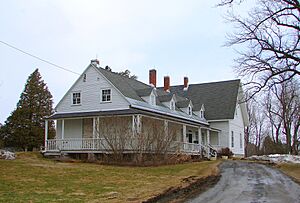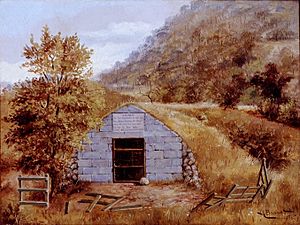Sir John Johnson, 2nd Baronet facts for kids
Quick facts for kids
Sir John Johnson
|
|
|---|---|

Sir John Johnson in 1792
|
|
| Superintendent General of Indian Affairs | |
| In office March 14, 1782 – January 4, 1830 |
|
| Preceded by | Guy Johnson |
| Succeeded by | Duncan Campbell Napier |
| Personal details | |
| Born |
John Wysen Bergh
5 November 1741 Amsterdam, New York |
| Died | 4 January 1830 (aged 88) Montreal, Canada |
| Spouses |
Clarissa Putman
(1765–1773)Mary Nicoll Watts
(m. 1773; |
| Children | 20 |
| Parents | Sir William Johnson, Bt Catherine Weissenberg |
| Relatives | Sir William Johnson, 4th Baronet (grandson) |
| Education | The Academy and College of Philadelphia |
| Military service | |
| Allegiance | Great Britain |
| Branch/service | King's Royal Regiment of New York |
| Rank | Brigadier general |
| Battles/wars | Revolutionary War |
Sir John Johnson, 2nd Baronet (born November 5, 1741 – died January 4, 1830) was an important leader in early Canada. He worked for the British Indian Department, helped people who stayed loyal to Britain during the American Revolution, and was a wealthy landowner. He was the son of Sir William Johnson, 1st Baronet, who was the first British Superintendent of Indian Affairs.
Sir John became a baronet and inherited his father's lands in 1774. During the American Revolutionary War, he moved to Canada with his family and friends to avoid being arrested by the rebels. In the war, he led a group called the King's Royal Regiment of New York. He was promoted to brigadier general in 1782. That same year, he became the Superintendent General and Inspector General of Indian Affairs. He held this job until he passed away in 1830. After the war, he helped give land in Upper Canada to Loyalists who had to leave their homes. He helped about 3,800 people settle in 1784. He also served in the government of Lower Canada.
Contents
Early Life and Family
John Johnson was born near Amsterdam, New York on November 5, 1741. He was the only son of Colonel Sir William Johnson, 1st Baronet, and Catherine Weissenberg. Catherine was a German immigrant. John was baptized as an Anglican in Fort Hunter. His father was a military leader during the French and Indian War. He helped British people settle in the Mohawk Valley and trade with the Mohawk people. His father also founded the town of Johnstown.
John's grandparents were Christopher Johnson and Lady Anne Warren. Lady Anne was the sister of Vice Admiral Sir Peter Warren. Their family was related to King William the Conqueror.
From 1757 to 1760, John studied at The Academy and College of Philadelphia. From the age of 13, he went with his father on military trips and meetings with Indigenous peoples.
A Career in Public Service
In 1771, Johnson became a Grand Master of Masons in the colonies of New York, New Jersey, and Pennsylvania. In 1774, after his father died, Johnson became the new baronet. He inherited his father's title and large estates, which made him a very rich landowner. In 1775, he was appointed as a doorkeeper for the New York General Assembly.
The American Revolution and Loyalists
In January 1776, after the American Revolution began, Johnson gathered hundreds of supporters in Johnstown. He wrote to Governor William Tryon, saying he could raise a group of soldiers for the British. He also said he could get 500 Indigenous warriors to help fight the rebels.
On January 20, 1776, General Schuyler and about 3,000 troops disarmed Johnson and his Loyalist supporters. Johnson was released on parole. In May 1776, Johnson heard that another group was coming to arrest him. He decided to escape to Canada with his family and supporters. He led about 170 of his tenants and allies from the Iroquois Confederacy to Montreal, Quebec. Because he was loyal to the King, he lost his home and land in the Mohawk Valley. The State of New York took all his property after the war.
Johnson and his followers formed a British military group called the King's Royal Regiment of New York. This group fought many battles against the New York colonials under his command. He was promoted to brigadier general in 1782.
On March 14, 1782, he was appointed Superintendent General and Inspector General of Indian Affairs. He took over from his cousin, Guy Johnson. Sir John took charge of Fort Niagara as the superintendent. This job gave him authority over all northern First Nations who were allied with the British Crown. This included four of the Iroquois League nations, many of whom had moved to Canada after helping the British during the revolution.
Life After the War
In 1783, the Treaty of Paris was signed. This treaty made the American Colonies independent. Johnson and thousands of other Loyalists had to live permanently in Canada. The British helped some Loyalists move to Nova Scotia. This included over 3,000 Black Loyalists, who were African Americans freed for their service during the war.
In 1784, Governor Haldimand asked Johnson to give out Crown lands to Loyalists who came to Canada. These lands were along the St. Lawrence River and the north shore of Lake Ontario. This was to help them make up for what they lost in the colonies. The government wanted to help this part of Canada grow, as it was not very settled. The Loyalists faced tough times at first, trying to build new homes in the wilderness. Johnson estimated he helped settle 3,776 Loyalists in the first few years. From 1787 to 1788, he worked with Colonel John Butler to get more land east of Toronto.
In 1791, Lord Dorchester suggested Johnson become the lieutenant governor of Upper Canada, but London did not approve this.
In 1796, Johnson moved back to Montreal, which was the capital at the time. He served in the Legislative Council of Lower Canada and led the Department of Indian Affairs for Lower Canada. He owned land in both Upper and Lower Canada.
Family and Legacy
From 1765 to 1773, Johnson had a relationship with Clarissa Putman. She was 15 years old and had Dutch and Mohawk family. They had a daughter and a son:
- Margaret Johnson (1765–c. 1830), who married James Van Horne in 1791.
- William Johnson (1770–1836), who was educated in Canada and became a lock master.
On June 30, 1773, Johnson married Mary Nicoll "Polly" Watts (1751–1815). She was the daughter of Hon. John Watts, who was President of the King's Council in New York. After Sir John escaped to Canada in May 1776, Lady Johnson was held by the Whigs in New York as a hostage. After she was freed, she joined Sir John in Canada. They lived in Montreal during the winter and spent summers on their land in Argenteuil on the Ottawa River. They also visited England. Mary and Sir John had ten sons and eight daughters. Eight of their sons served in the British army and navy. Their children included:
- Anne Nancy Johnson (1774–1848), who married Colonel Edward MacDonnell.
- William Johnson (1775–1811), a Lieutenant Colonel in the Army.
- Warren Johnson (1777–1802), a Major.
- Adam Gordon Johnson (1781–1843), who became the next baronet after his father.
- John Johnson (1782–1841), a Colonel-Commandant.
- James Stephen Johnson (1785–1812), a Captain who died at the Siege of Badajoz.
- Catherine Maria Johnson (1786–1850), who married Major-General Barnard Foord Bowes.
- Robert Thomas Johnson (1787–1812), a Captain who drowned in the St. Lawrence River.
- Charles Christopher Johnson (1787–1864), a Lieutenant Colonel in the Army.
- Archibald Kennedy Johnson (1792–1866).
Lady Johnson died in Montreal on August 7, 1815. Sir John died in Montreal on January 4, 1830, at the age of 88. He was still the Superintendent of Indian Affairs. Both are buried in a vault at Mount Johnson, near Chambly, Quebec.
Honors and Remembrance
- The Sir John Johnson House in Williamstown, Ontario, was named a National Historic Site of Canada in 1961.
- Lac Sir John, a small lake near Lakefield, Quebec, is named after him. The road Chemin Lac Sir John is also named for him.




